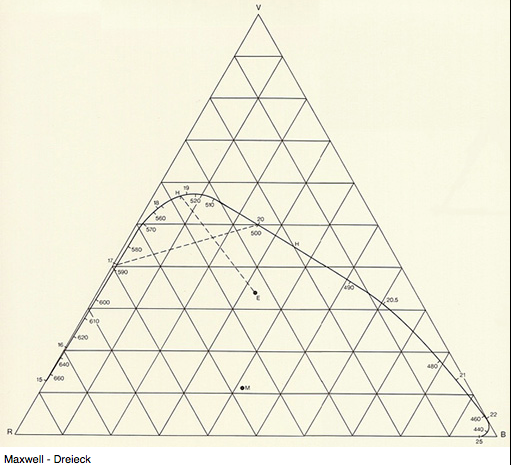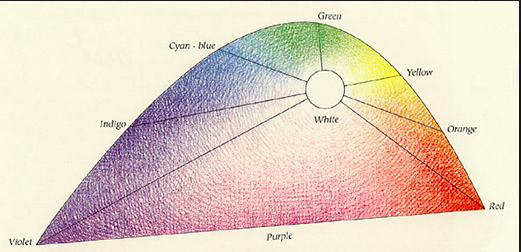Hermann von Helmholtz was a German physician and physicist. He was born in 1821 in Potsdam, Germany and died in 1894. Hermann von Helmholtz was a pioneer in several scientitv fields, and made significant contributions. In the field of physiology and psychology he is specially known for his studies of the mathematics of the eye, ideas on visual perception of space and colour vision research. In 1851, Helmholtz became world famous, after his invention of the ophthalmoscope – an instrument that could examine the inside of the human eye. Together with Thomas Young, an English physician, he developed a theory of trichromatic colour vision. The theory assumed that the eyes retina consist of three different kinds of light receptors for red, green and blue. The trichromatic theory was quickly accepted, so Hermann von Helmholtz continued to study colour.
The colour diagram appeared for the first time between 1856 and 18867 in his famous manual of psychological optics. here, Helmholtz introduces three variables; hue, saturation and brightness, all which we are still using to characterize colour. These variables were chosen to correspond to the three parameters of sound, amplification, pitch and timbre. Helmholtz discovered that the only difference between sound and the perception of colour is that the eye cannot differentiate between the components of a mixed colour, while the ear can easily identify separate elements of sound.
Helmholtz was the first to demonstrate that the colours which Newton has seen in his spectrum are different from colours applied to a white base using pigments. He discovered how spectral colours shine more intensely and possess greater saturation(1). In the manual he also submits that James Clerk
Maxwell’s triangle  is too small to accommodate the saturated spectral colours, and that Newton’s colour spectrum neither did explicitly refer to trichromatic theory. In the colour diagram, the spectral
is too small to accommodate the saturated spectral colours, and that Newton’s colour spectrum neither did explicitly refer to trichromatic theory. In the colour diagram, the spectral
colours is arranged on a curved line  , to achieve a better understanding of their mixtures. In order to attain white, Helmholtz discovered that it did not require equal quantities of violet-blue and yellow for example. The diagram is instead arranged so that the complementary colours that required a bigger amount to obtain white, were given a greater authority. Helmholtz then did a modified version of Maxwell’s construction of the triangle, and arranges the colour diagram inside the triangle, with the spectral colours having varying distances to white, which lies in the center of the triangle.
, to achieve a better understanding of their mixtures. In order to attain white, Helmholtz discovered that it did not require equal quantities of violet-blue and yellow for example. The diagram is instead arranged so that the complementary colours that required a bigger amount to obtain white, were given a greater authority. Helmholtz then did a modified version of Maxwell’s construction of the triangle, and arranges the colour diagram inside the triangle, with the spectral colours having varying distances to white, which lies in the center of the triangle.